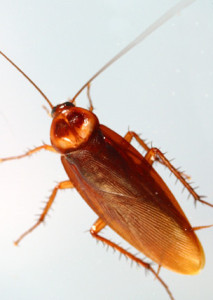
Ensign wasp, Evania appendigaster. The dark, flag-like abdomen, here just visible behind the wings, gives the insect its name.
The ensign wasp is one of the odder insects found occasionally in homes. A small insect, only 5-7 mm long, it does not sting or bite. In fact, it does no harm; but it is a beneficial parasite of at least three household cockroaches, the American cockroach being the most common.
Ensign wasps are experts at locating not the cockroaches themselves, but the egg cases (oothecae) that cockroaches deposit. According to one account, when the female ensign wasp encounters a cockroach egg case, she first taps it with her antennae, presumably to confirm that it is an acceptable host for her egg. Then she lies down beside it (I have never heard of an insect voluntarily lying on its side before!) and braces her legs against the ootheca. After much labor she inserts her slender ovipositor into the tough ootheca and lays a single egg. After hatching, the wasp larva matures while feeding on the dozen or more cockroach eggs inside each ootheca. No cockroaches will hatch from an egg case that has been parasitized by an ensign wasp.
The name ensign wasp comes from the unique, stalked abdomen. Shaped like a sailor’s signal flag, she frequently waves her abdomen up and down while stalking her prey as if to say, “Here I am! Look out cockroaches!”
If you find an ensign wasp in your home, there’s no need to panic. It likely means that one of the larger species of cockroaches (American, Smoky brown, or Oriental cockroaches) is present somewhere inside the structure. I see one or two of these wasps in my office building every year. I know they come from the rarely seen population of American cockroaches lurking in the walls and ceilings of our office building–something found in nearly every commercial building. I like to think that we don’t see a lot of cockroaches because we have these little wasps keeping watch.
If you see these wasps AND see cockroaches on a regular basis, you may want to consider some control action. Against the cockroaches, not the wasps! One home owner recently swore that the ensign wasps were coming at her, and were tough to kill. Not true, though they do look impressive when they wave their little flags. The only ones who should get nervous about ensign wasps are the cockroaches.
For more information about cockroaches around the home, see the fact sheet Cockroaches and Their Control.
